 W
WBullfighting is a physical contest that involves a bullfighter and animals attempting to subdue, immobilize, or kill a bull, usually according to a set of rules, guidelines, or cultural expectations.
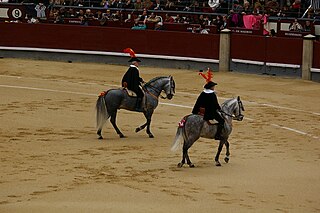 W
WThe alguacilillo is a horseman who parades at the head of the paseíllo and wears 17th century alguacil clothes. He receives from the president of the corrida the (simulated) keys of the bullpen. They ceremonially perform the rule of law during the bullfight and transmit the orders from the president to the toreros.
 W
WA corraleja is a bullfighting festival in the Caribbean region of Colombia. In this type of event, the public is invited to engage the bulls in the ring. Compared a Spanish-style bullfight, the bulls are not killed after the fight, and the event is much less formal.
 W
WThe course landaise is an ancient form of bullfighting and bull-leaping held in oval or rectangular arenas covered in sand, that involves no bloodshed. Experienced cows, with large horns, aged generally from 2 to 14 years old, are used instead of bulls. They are athletic but small animals selected from the same breed as the bulls used for the Spanish corridas. In Gascony, it is a major spectator sport, counting as many as 600 events each year.
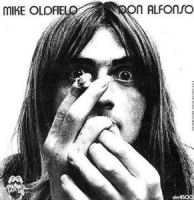 W
W"Don Alfonso" is the second UK single by musician Mike Oldfield, released in 1975. Side 1 has an additional credit: "featuring David Bedford on vocals". This is a comic novelty song from the 20th century, sung by a boasting, bogus toreador, who seems to know very little about bullfighting.
 W
WDon Tancredo was a bullfighting technique which was popular in the first half of 20th century. It consisted of a person, who plays the part of Don Tancredo, who waits for the bull whilst standing on a pedestal located in the middle of the bullring. The performer was dressed in period or comic costume and was painted completely white. He had to remain quiet in order to (supposedly) make the bull believe the person was a statue and therefore not attack him because of fear of the hardness of marble.
 W
WL'Écho taurin was a publication from Béziers, France which called for support to 'bull-fighting and southern freedoms'. It was founded as a weekly newspaper in 1882. In 1932 it became a seasonal publication. In the 1930s, its director was J. Rodriguez.
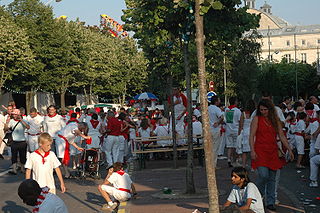 W
WA feria is an annual local festival in Spain and southern France, characterized by bullfights, bull running in the streets, bodegas and bandas. The word festayre means ferias' partiers.
 W
WFeria del Sol, or Carnaval Taurino de America, is an international cultural festival held in the city of Mérida, Venezuela every February of the year. The Feria festival is held alongside the carnival feast. The festival includes bull competitions, cultural expositions, commercial and zootechnic expositions, concerts, parades, sports, and a voting competition for La Reina Del Sol.
 W
WIslero was a Miura bull famed for killing the celebrated bullfighter Manolete on August 28, 1947. Bulls from the Miura ranch, located near Seville, Spain, are known for being large and ferocious.
 W
WJallikattu, also known as eru thazhuvuthal and mañcuvirattu, is a traditional event in which a bull, such as the Pulikulam or Kangayam breeds, is released into a crowd of people, and multiple human participants attempt to grab the large hump on the bull's back with both arms and hang on to it while the bull attempts to escape. Participants hold the hump for as long as possible, attempting to bring the bull to a stop. In some cases, participants must ride long enough to remove flags on the bull's horns.
 W
WMexican Hayride is a musical with a book by Herbert Fields and Dorothy Fields and music and lyrics by Cole Porter. The show opened on Broadway in 1944.
 W
WThe Spanish Fighting Bull is an Iberian heterogeneous cattle population. It is exclusively bred free-range on extensive estates in Spain, Portugal, France and Latin American countries where bull fighting is organized. Fighting bulls are selected primarily for a certain combination of aggression, energy, strength, and stamina. During the breeding, in order to preserve their natural characteristics, the bulls rarely encounter human beings, and if ever, never on foot.
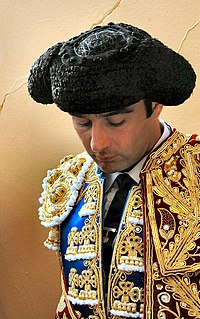 W
WA montera is the hat traditionally worn by many males and females in the folk costumes of the Iberian peninsula. It has come to name also but not exclusively the ones used by bullfighters, introduced to the event in 1835 by Francisco "Paquiro" Montes as accompaniment to the traje de luces, or "suit of lights".
 W
WA muleta is a stick with a red cloth hanging from it that is used in the final third of a bullfight. It is different from the cape used by the matador earlier in the fight.
 W
WPasodoble is a fast-paced Spanish military march used by infantry troops. Its speed allowed troops to give 120 steps per minute. This march gave rise to a traditional Spanish dance, a musical genre including both voice and instruments, and a genre of instrumental music often played during bullfight. Both the dance and the non martial compositions are also called pasodoble.
 W
WPortuguese-style bullfighting differs in many aspects from Spanish-style bullfighting, most notably in the fact that the bull is not killed in front of an audience in the arena. The cavaleiros and the forcados are unique to the Portuguese variety of bullfighting, as well as the participation of horsewomen (cavaleiras) in the routines.
 W
WRatón was a Spanish fighting bull that was nicknamed el toro asesino, el sangriento toro and el terrible Ratón for killing three people in bullfighting rings in Spain during 2006–2011 and injuring thirty more. The bull became legendary in Spain due to the large number of gorings for which he was responsible. Bullfighting fans regarded him as a star and traveled from across the country to see the morlaco at his home at Sueca near Valencia. Matador Jesús Esteve said of Ratón: "He is a killer. He is lazy, he doesn't want to participate. He does his own thing, waiting for somebody to make a mistake. And then when he gets you, he wallops you, and he doesn't let up."
 W
WThe Spanish Fighting Bull is an Iberian heterogeneous cattle population. It is exclusively bred free-range on extensive estates in Spain, Portugal, France and Latin American countries where bull fighting is organized. Fighting bulls are selected primarily for a certain combination of aggression, energy, strength, and stamina. During the breeding, in order to preserve their natural characteristics, the bulls rarely encounter human beings, and if ever, never on foot.
 W
WSpanish-style bullfighting is a type of bullfighting that is practiced in Spain, Mexico, Colombia, Ecuador, Venezuela, Peru, as well as in parts of southern France and Portugal. This style of bullfighting involves a physical contest with humans attempting to publicly subdue, immobilize, or kill a bull. The most common bull used is the Spanish Fighting Bull, a type of cattle native to the Iberian Peninsula. This style of bullfighting is seen to be both a sport and performance art. The red colour of the cape is a matter of tradition – bulls are color blind. They attack moving objects; the brightly-colored cape is used to mask blood stains.
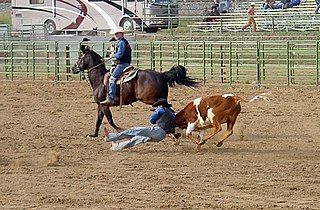 W
WSteer wrestling, also known as bulldogging, is a rodeo event in which a horse-mounted rider chases a steer, drops from the horse to the steer, then wrestles the steer to the ground by grabbing its horns and pulling it off-balance so that it falls to the ground. The event carries a high risk of injury to the cowboy. There are some concerns from the animal rights community that the competition may include practices that constitute cruelty to animals, but the injury rate to animals is less than five-hundredths of one percent. A later PRCA survey of 60,971 animal performances at 198 rodeo performances and 73 sections of "slack" indicated 27 animals were injured, again approximately five-hundredths of 1 percent – 0.0004.
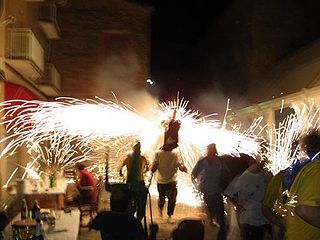 W
WA toro de fuego, also known as vaca loca in Colombia, Peru and Ecuador, is a festive activity in which a metal frame resembling a bull, with fireworks attached to it, is set alight, and then the person carrying the frame runs around town at night as if chasing people in the streets. Participants dodge the bull when it comes close, especially because the burning fireworks set off sparks that can cause small burns in people's skin or clothes. This activity is held in a number of Spanish towns during their local festivals. It is possible that this custom originated in the Toro embolado, in which a real bull is involved.
 W
WThe traje de luces is the traditional clothing that Spanish bullfighters wear in the bullring. The term originates from the sequins and reflective threads of gold or silver. These trajes are based on the flamboyant costumes of the 18th-century dandies and showmen involved in bullfighting, which later became exclusive to the bullfighting ritual. Later adornments include the montera hat, more elaborate embroidery, and decorative accessories.
 W
WSpanish-style bullfighting is a type of bullfighting that is practiced in Spain, Mexico, Colombia, Ecuador, Venezuela, Peru, as well as in parts of southern France and Portugal. This style of bullfighting involves a physical contest with humans attempting to publicly subdue, immobilize, or kill a bull. The most common bull used is the Spanish Fighting Bull, a type of cattle native to the Iberian Peninsula. This style of bullfighting is seen to be both a sport and performance art. The red colour of the cape is a matter of tradition – bulls are color blind. They attack moving objects; the brightly-colored cape is used to mask blood stains.